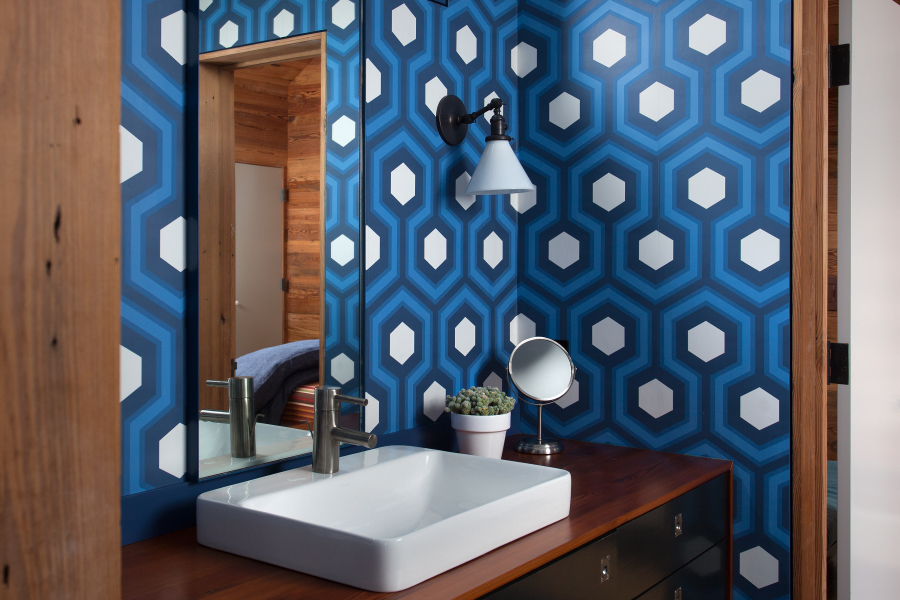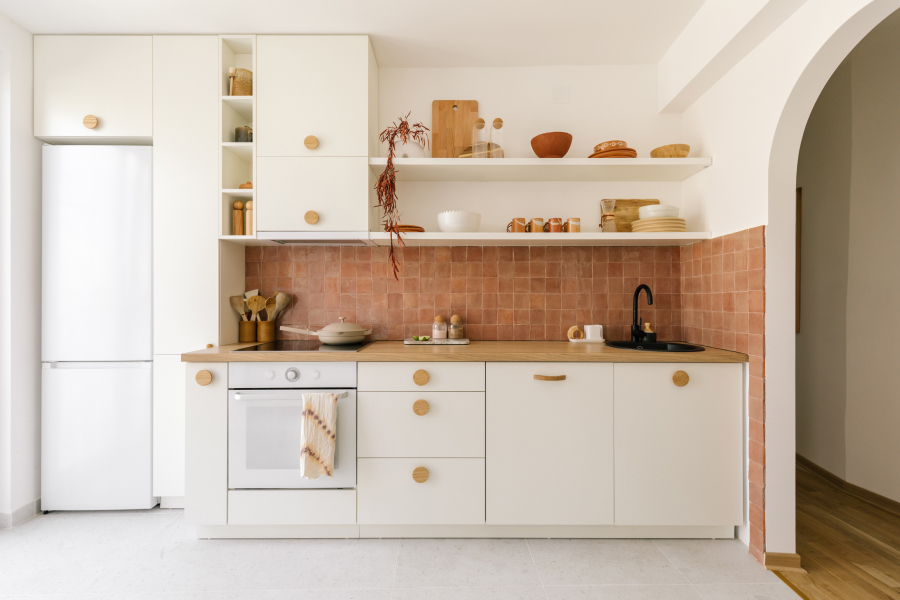- calendar_month June 30, 2023
An interior designer explains how to be intentional with color to boost your mood in every room.
Painting your kitchen blue can ruin your appetite, while painting your bedroom red can prevent you from unwinding at the end of a long day. You may be thinking, “Hold on, but I just found the perfect shade of turquoise to match my stand mixer!” But the colors you choose to decorate your home can powerfully alter your mood, for better or for worse. They may make you feel more productive or creative in your kitchen, or more relaxed in your living room. Choose the wrong color, and you may literally lose sleep over it.
This school of thought is part of a broader concept called color psychology — the study of how colors affect human emotions and behavior. Color psychology principles are the foundation for designer and color expert Mehnaz Khan when working with her clients on transforming their homes — and feeling their best in them.
“Color psychology is an alternative medicine,” says Khan, who explains that using colors wisely in her own home helped her overcome seasonal depression. “We live in a world where everybody’s trying to play it safe [with color]. Colors have a psychological impact on us. They’re not just about décor and beautifying things.”
A room’s function and purpose is important when applying color psychology, according to Khan. In her work, Khan asks her clients how they want to feel in particular spaces in their home and what time of day they use that specific room. From there, she creates a custom color palette that supports that purpose and intention.
Of course, sometimes the function of a room can win over home buyers. In a recent Zillow virtual panel, Khan even explained the psychology of color to help people understand which colors could increase their home value.
We asked Khan how to be intentional with color and if there was a rule of thumb for every room in the house. While it’s not one-size-fits-all for every homeowner, Khan shared some tips to get started, from key colors to avoid in order to achieve certain desired results, to how to think about saturation.
Now grab a notebook — perhaps a colorful one — and let’s dive in.
Best paint colors for each room
Bedroom
The bedroom is meant to be a calming and soothing space that promotes sleep and relaxation. In this room, Khan says, it’s important to focus on “low-intensity colors,” shades that are less-saturated, and thus tend to be less stimulating. Low-intensity colors, like light green and light blue, can help you create and foster a relaxing environment. Go with these shades for your walls, especially if you have a hard time falling asleep at night.
Red, on the other hand, is a no-go. Red — especially highly saturated, bright red — is an activating color, which means it can make you feel hyperactive. This is not what you want in your bedroom. Save your ruby and rose tones for rooms in the house where your goal is to stay alert and energized.

Bathroom
There’s more than one answer when it comes to picking the right color for a bathroom. If you’re painting a kid’s bathroom and you’re looking to create an environment that will help them wake up and feel alert in the morning, go with a bright, fun color, like turquoise. However, if you’re looking to create a spa-like ambience that helps you unwind, Khan recommends incorporating dark blue or purple colors into your bathroom.
If you don’t have any specific vision for the type of environment you want to create in your bathroom, whites and other neutrals are a safe choice. They give the bathroom, a space that tends to be one of the smallest rooms in your home and filled with products, a clean, streamlined look, Khan says. Consider white if you’re the type of person who gravitates towards a more minimalist style or you are generally looking to create more order for yourself.

Kitchen
“The activity that happens in the kitchen — cooking — is very physical and emotional,” Khan says. While red may keep you up late at night in a bedroom, Khan points out it’s perfect for the physical activity that takes place in your kitchen. Looking to take your cooking game up a notch? Consider pairing red with yellow, a color associated with feeling happy and energetic, she says.
If red feels a tad too high intensity, Khan recommends painting your kitchen walls a light shade of yellow or white, but then integrate bright yellow and red accents with your kitchen appliances. (Hello, retro red fridge!) Doing so can still be rewarding and pay off when it comes to boosting your mood in the kitchen.
Blue, however, is a big no-no in the kitchen. “The color blue kills the appetite,” Khan says, adding that it’s important to look at which colors are prominent in nature. “Nature has not created blue food.”

Living Room
When picking paint colors for rooms where you spend a lot of time — like the living room — it’s natural to play it safe and opt for white, and that’s not necessarily a bad thing. Khan compares using color wisely to eating a balanced diet that includes veggies, protein and carbs. There’s nothing wrong with picking a white or gray for the walls if you’re open to experimenting with pops of color in the other details throughout the room.
But you may want to think twice before committing to that pop of color in your couch, Khan suggests — you don’t want to have to change your sofa every two years when you get sick of it.
Playing around with colorful pillows, however, is encouraged. For example, if you’re a fan of red, decorate a neutral-toned sofa with one or two red pillows. “Doses really matter,” Khan says, highlighting that it’s not only important to pay attention to how much color you use, but where you’re using it. A colorful rug on the floor, for example, tends to have less impact on your mood versus a paint color on the wall because the floor is far below the normal eye-level.
Feeling bold? Go with green walls in the living room. Green is a great choice for creating an inviting and comfortable space, Khan says, because “it’s balancing and relaxing, and it connects us to nature.”

Dining Room
The dining room is where people gather to connect over meals and conversation, so it should feel inviting and warm. Khan recommends leaning on green for this environment and integrating “doses of red, yellow and orange” to create a welcoming atmosphere. And like the kitchen, you’ll want to avoid the color blue in your dining room, Khan says.
Home office
If you’re looking to use your office as a place to stay grounded, zone in and focus, go with the color blue. “Blue is the color of intellect,” Khan said. “It engages the mind.” She recommends balancing out the distribution of high-intensity and low-intensity colors. High-intensity blues — like cobalt and turquoise — are brighter, and therefore, more stimulating, whereas low intensity blues — like sky blue and periwinkle — are more relaxing.
If you’re looking to enhance your productivity and get your mind churning, Khan recommends introducing high-intensity blues in a home office. However, she suggests avoiding extremely dark blues, like navy, because it can make your space feel too enclosed. Meanwhile, if you have a job that requires and involves a lot of creativity, you’ll want to find ways to add bursts of yellow, orange and pink into your office.
Ultimately, picking the colors for the rooms in your home can and should be fun. It’s a process that allows you to tap into your creativity. Give yourself the time and space to think about what mood you want for each room, and let your mind run wild from there. Color is a beautiful thing, and using it wisely will serve you — and your home — well.
